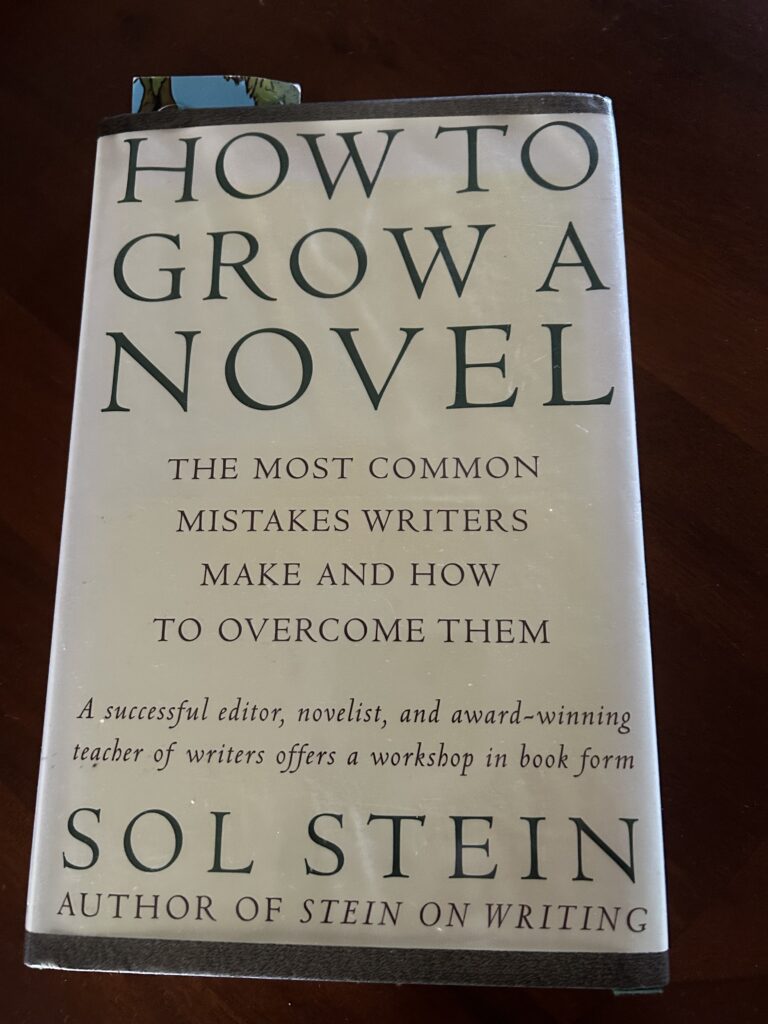I’m a strong believer in learning writing craft. It amazed me when I first took up writing how much there is to learn, and that it’s not a case of throwing the words on paper and checking for typos. (Honestly, it really isn’t!) It’s why I rewrote all three books of Guardians of the Forest: I’d learned so much after a few years my pride wouldn’t allow me to have them out there in their original state.

Craft fascinates me, which means I enjoy researching for the Writer’s Corner in my monthly newsletter and sharing the findings, as well as working hard to incorporate best practice in my own work.
So when How to Grow a Novel by Sol Stein was mentioned, I had to have a copy. In this post I share a few of Stein’s key points to good novel-writing which I suspect were pretty new then, but have stayed the test of the last 25 years.
Stein’s first point is that ‘the reader is looking for an experience’
We hear this today when promoting our work, drafting book blurbs, or posting on social media, paid and free. What will your book make the reader feel? We need to have an idea about that as we’re writing. Then, as reviews come in telling us what emotions individual readers actually experienced as they read our story, we get what’s called ‘social proof’ (hopefully). The book is doing its job.
What we don’t want to do is bore the reader. Stein quotes from Kingsley Amis: ‘… I try to visualise him and watch for any signs of boredom or impatience to flit across the face of this rather shadowy being, the Reader.’ Great advice!
But how do we make sure the reader’s experience is the one we want? And that we don’t bore them? Here are Stein’s key elements with some comments of my own.
‘Characters who are characters’
Make your characters, and especially your protagonists, different, memorable, without turning them into caricatures. Stein also prefers to call the antagonist a protagonist as well, to help avoid making them a pure villain. They have needs and motives too, not necessarily ideal ones, but there are reasons for their actions just as there are for the hero.
However quirky your characters are, Stein says, they also have to reveal their humanity, for it’s their ‘hopes, temptations, joys, triumphs, vulnerability and sadness’ which ensures the reader takes them to heart.
Conflict: ‘Readers enjoy conflict because it is in fiction and not in their lives’
A ‘spine of conflict’ is necessary throughout the tale, Stein says. This is another idea well and truly adopted by today’s writing gurus. Whatever your genre, every scene should contain conflict. Stein, however, argues that we don’t need constant conflict, as this will soon wear the reader out. But we do need to use those resting scenes sparingly and – here’s a challenge – in a way ‘which provokes the resting reader’s curiosity.’ Perhaps a bit of foreshadowing, for example, a hint of potential conflict or resolution?
Stein’s definition of conflict is wide. He prefers to refer to ‘adversarial’ writing, to take away the perceived need to create active, perhaps violent, conflict. He uses words like suspicion, opposition, confrontation, and refusal, to describe conflict. These can be conveyed – my words now – with the lift of an eyebrow, through measured tones in pertinent dialogue (an ideal way to convey conflict according to Stein), by the shift of a hand on a table. Conflict can be subtle, it doesn’t have to involve slammed doors, knives or shouting. But it has to be a thread throughout the tale.
Action: ‘If there is no action, there is no scene’
Something has to happen. Get rid of those narrative passages, those things which happened ‘off stage’. Translate them into direct action using a character’s point of view. Assuming they actually contribute to the story, of course. The same with ‘told’ passages, where action is reported through dialogue – a not so clever trick we employ to kid ourselves we’re not using authorial intervention.

The test of this is what Stein calls ‘filmability’. You should be able to see every scene taking place as if it was a film, because films are all about action – even subtle action like the way two characters interact, their shared looks, how they stand, how close together they are.
Dialogue: ‘often postpones the answer [to a question] to create suspense’
Dialogue is one of the things I see writers get wrong so often. They think readers want to hear ‘realistic’ dialogue. Think about that for a minute – do you really want to read the ramblings of your loved ones, the conversations you have with the chatty supermarket checkout clerks? No, readers want dialogue that involves oblique responses, to create tension. And they want it snappy, and preferably confrontational, however low key that confrontation might be. Here’s a popular post of mine on dialogue.
Scene endings: ‘Never give the reader what they want’
There has to be an unanswered question, an unresolved issue, at the end of each scene to keep the reader turning the pages. Makes sense, right? (Here’s a post of mine on Endings.)
There’s much more …
These are a few of the early points which jumped out at me, generally things I’ve learned over the years, but great to have them repackaged and presented as a fresh reminder. Stein gives a lot of editorial hints as well, and it’s my intention to summarise those in next month’s post. I’ll be reading them carefully as I get into editing The Winter of the White Horde, the long in the making sequel to Guardians of the Forest.
As ever, let me know your views on any of this. I love to chat about writing!
Find more writing tips here. Search for topics using the search bar at the bottom of the page.